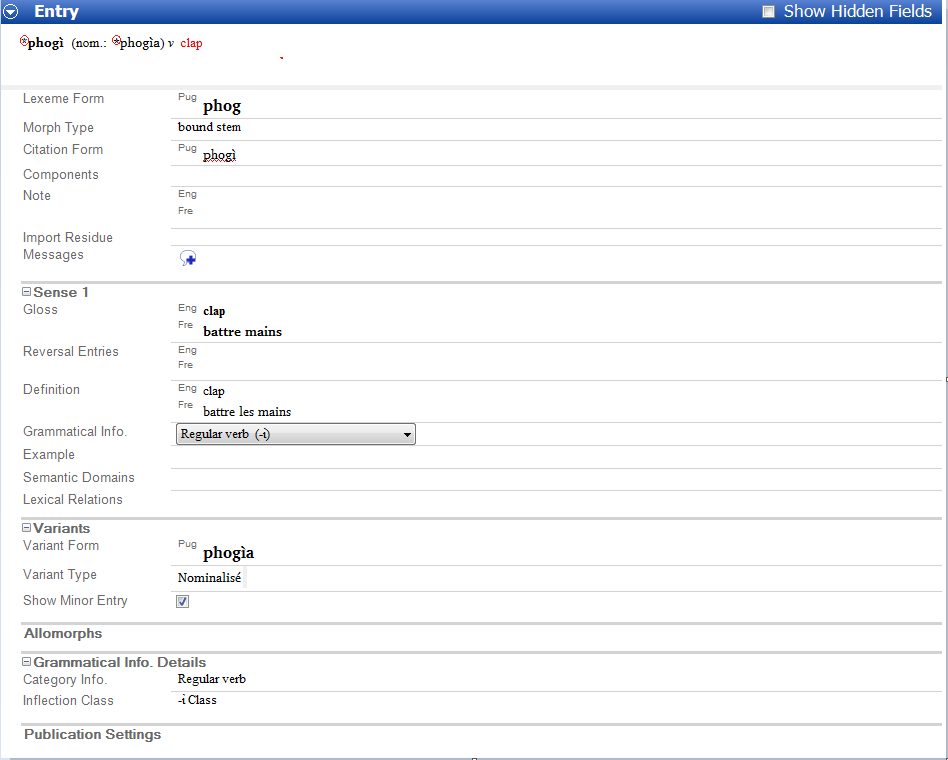Need help eliminating asterisk (from bound stem) in dictionary
Kevin Warfel
I’m continuing to struggle in my attempt to master the dictionary-formatting component of FLEx. Today I’m wanting to find a way to get rid of the asterisk that FLEx uses to indicate that something is a bound stem. My Lexeme Form is a bound stem and requires a suffix in order to be recognizable by speakers of the language. I use this form for parsing, but it does not appear in my dictionary at this point. Should I decide in the future to include the Lexeme Form in the dictionary entry, I would expect and want the asterisk to appear there to show that it is a form that requires affixation. However, I have filled in the Citation Form field with the inflected form that speakers of the language will recognize, and some of my entries also have an irregularly inflected variant. When the contents of the Citation Form and Variant fields show up in my dictionary entry, I do not expect, nor do I want an asterisk to appear with them because these are fully inflected forms. How do I make this asterisk disappear?
Here is a screen shot of a typical verb entry in my database, with the undesired asterisks circled in red:

Thanks for any help you can give!
Kevin
Hanna
I only know how you can completely delete the asteriks from your bound stem.
Go to Lists -> Morpheme Types -> Bound stem -> Leading Token. (Delete the asterisk there.)
But I guess this does not solve your problem as you would like to have it on the lexeme form but not on the citation form. Not sure if this is possible, it would mean that the citation form would have another morpheme type (stem) then the lexeme form (bound stem).
For variants this should be possible as they are stored in a seperate entry, and there you can specify a different morpheme type.
Although this does not solve your problem entirly, maybe it gives some hints?
Hanna
Kevin Warfel
Thanks, Hanna. That is indeed a way to get rid of the unwanted asterisks, and so long as I don’t decide to include the Lexeme Form in my dictionary, that solves my problem. Sometimes, though, the dictionary user may need to know what the stem of a particular verb is in order to be able to properly inflect its various forms. That’s one potential motivator for including the Lexeme Form in the entry. For example, a verb whose Citation Form is CṼ in nature (consonant + nasalized vowel) may underlyingly be one of two types (CṼ- or CVC-), and the structures of the other inflected forms of those verbs are quite different, depending on the form of the stem.
Citation Form (incompletive) completive “stative” nominalized stem
cɔ̃ cɔ̃ɔ̀ cɔ̃ɔ̀ cɔ̃ɔ̀lɔ cɔ̃-
cõ colé coloò colìa col-
So someone encountering the form cɔ̃ or cõ in the dictionary would not know if they were underlyingly CṼ- or CVC-, and if the latter, what the nature of the final C is, unless it is supplied somewhere in the entry. Without that information, the other inflected forms could not be predicted. So, as I think about this, it seems unavoidable that I will want to somehow include the Lexeme Form in the entry. But I may use a custom field, since that information will only be necessary for the ambiguous forms, rather than for all verbs in the language.
This is for a more general audience, though you’re welcome to respond if you like, Hanna:
I find it surprising that FLEx should not be capable of treating the Lexeme Form as bound while viewing the Citation Form as at least potentially different than that. It seems to me that only the Lexeme Form field should be associated with a Grammatical Category; the contents of the Citation Form field is for presentation only. At least that’s the way I’ve viewed these fields. Am I wrong?
I’m sure there may be use cases I haven’t thought of, but to my way of thinking, the primary reason for filling in both of these fields is that what one wants to present in the dictionary is different than the underlying form, and at least in many (if not most) instances, this is because the stem is bound and the native speaker would find it nonsensical if it were presented without it being inflected in some way. When the contents of the Lexeme Form field match what I want to have appear in the dictionary, I leave the Citation Form field blank.
Am I using these two fields in an unanticipated manner?
Thanks again, Hanna. I look forward to receiving responses to the questions I’ve asked here.
Kevin
Thanks for any help you can give!
Kevin
--
You are subscribed to the publicly accessible group "FLEx list".
Only members can post but anyone can view messages on the website.
---
You received this message because you are subscribed to the Google Groups "FLEx list" group.
To unsubscribe from this group and stop receiving emails from it, send an email to flex-list+...@googlegroups.com.
To post to this group, send email to flex...@googlegroups.com.
To view this discussion on the web visit https://groups.google.com/d/msgid/flex-list/d81c4973-1c8b-4c5d-8122-1c1724137117%40googlegroups.com.
For more options, visit https://groups.google.com/d/optout.

